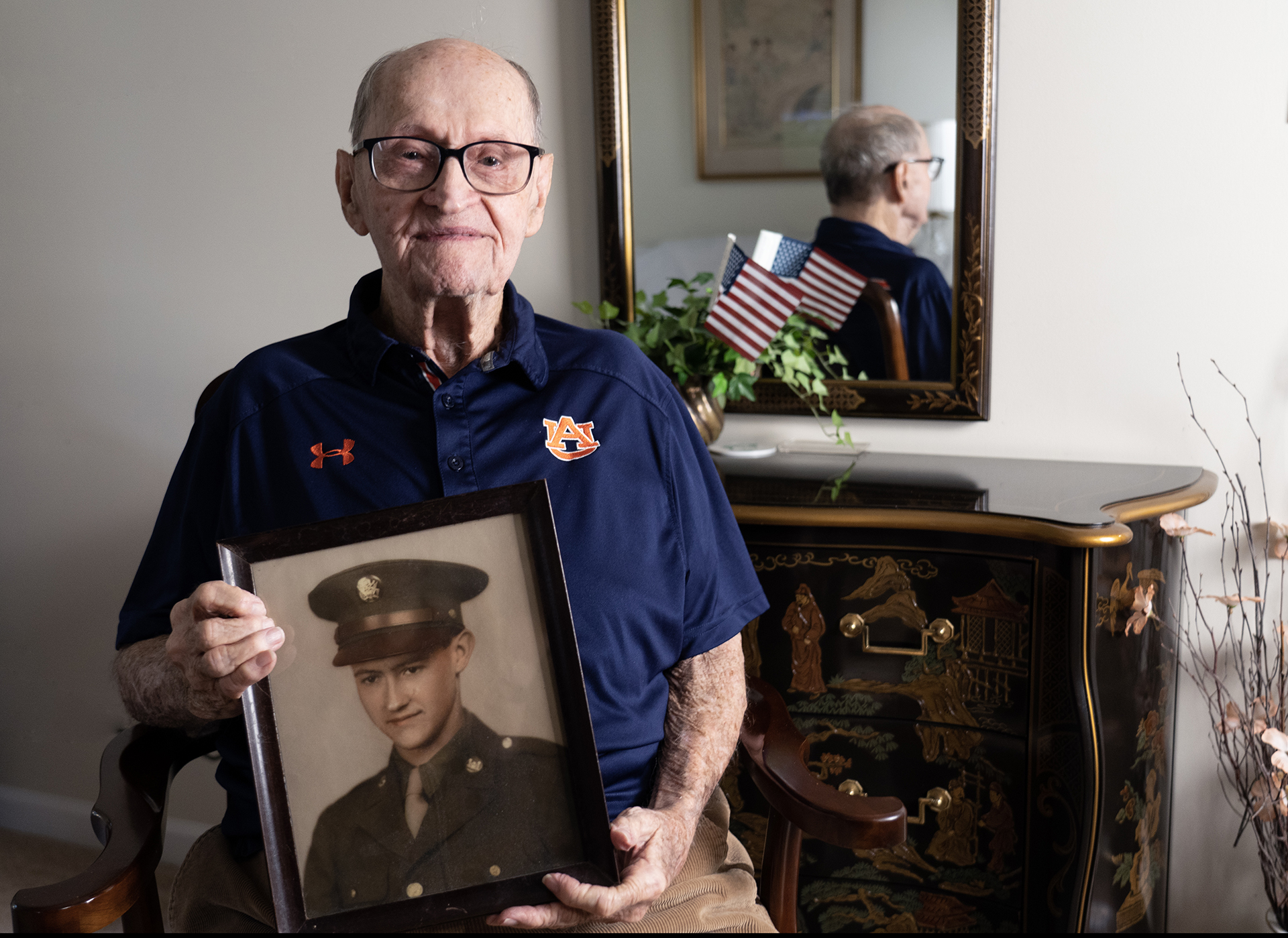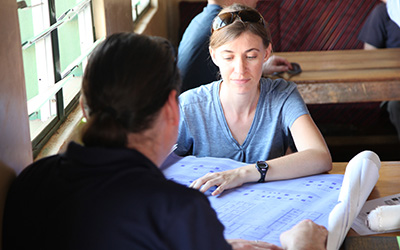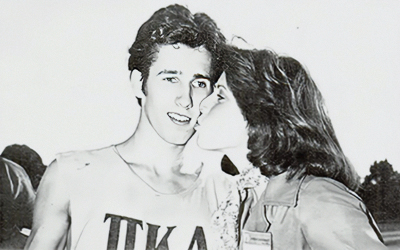Auburn grad invests in his alma mater for more than 65 years
By Kendra Carter ’08

Catesby ap C. Jones ’49 in his Selma home, holding a framed portrait from his days in the U.S. Army. He was drafted in 1944.
A love of Auburn runs deep for Catesby ap C. Jones ’49.
“You know, some people say they bleed orange and blue, but for me, Auburn is in my gut,” Jones said. “There’s just something about Auburn and the Auburn spirit—it stays with you and it’s different from any other school.”
And when something stays with you for that long, you find ways to give back.
Jones is the university’s longest consecutive donor on record, with his first gift documented in 1957. With his support over the course of 65 years, Jones is a member of Auburn’s 1856 Society, one of the university’s most prestigious giving societies.
“I don’t know any other way to say that I just love Auburn,” he said. “It’s special to me and I could do a little to help it be special for other people along the way.”
Service to Country
Born in Selma, Ala. on April 19, 1925, Jones—now 98—is the son of Catesby ap R. Jones and Elizabeth Beers Jones. The family is one of Dallas County’s most historic and uses a Welsh naming convention that places “ap” in the names of its male members, which means “son of.”
After graduating from high school in 1943, Jones enrolled at the nearby Marion Military Institute. He—along with both his father and his brother Roger ap C. Jones—served in the U.S. Army during World War II. Jones was drafted into the war in 1944 to serve with the Army Corp of Engineers in Europe.
“I was in a war zone, but my company didn’t get into any of the fighting part,” Jones said.
He arrived in SouthHampton in England on Dec. 21, 1944 and was assigned to Company A, 1280th Engineer Combat Battalion. The company traveled across France to the German front and began clearing debris and constructing bridges when they arrived in January 1945.
“It was all blown up when we got there,” he said. “Our company did pick up on minefields and worked on highways. And, in fact, our last thing we did was build a Bailey Bridge on the Rhine River. Gen. [George S.] Patton used that bridge for some of his tanks to go all the way to Berlin.”
Jones said that while building the bridge in Germany, he injured all the ligaments in his knee and spent three months in a French hospital before being flown back to the U.S. to rehab hospitals—first in New York, then Mississippi and finally Florida. He came back home to Selma in April 1946 after being released from active duty.
An Auburn Man
Former Auburn President Luther Duncan once estimated that nearly 800 veterans from World War II would enroll at Auburn through the G.I. Bill, but in his in June 1946 report to the Board of Trustees, Duncan reported that a “tidal wave of students had descended on Auburn”—many were veterans returning home from war—with enrollment growing one academic year from 1,162 to 4,383.
In June 1946, Catesby Jones was one of them.
“A bunch of the guys I roomed with had been in the Air Force, and we lived on South Gay Street with a lady who owned a rooming house,” he said.
Majoring in business administration, Jones said Ralph Brown Draughon, who would soon become Auburn’s 11th president, was a mentor during his studies and inducted him into the business fraternity Delta Sigma Pi.
After graduating in spring 1949, Jones returned to Selma to work for two years before moving to Mobile to work for his father at Mobile Fire & Marine Insurance Agency. He worked for other companies as well in auditing and management until he moved back to Selma to join his father in an insurance and investment management business, Mabry Securities. He continued work there until he sold the business when he retired in 1985.
Through his success in business he was asked to serve on the board of what would become Regions Bank, a position he held for many years until he retired from the board in 1997.
Giving Back
Jones began giving back to Auburn soon after graduation. Through the years his philanthropy has helped support Auburn University Athletics, the Harbert College of Business and the Ralph B. Draughon Library, among other areas of impact on campus.
In addition to financial contributions, Jones donated a collection of presidential letters to Auburn Libraries and Special Collections in 2017.
The collection included several historical documents, including letters written to Gen. Roger Jones—Jones’ great-great-grandfather—who was an officer in the United States Marine Corps and Army. He was the longest-serving adjutant general in U.S. Army history, serving under Presidents James Madison, James K. Polk and John Tyler. One letter included an invitation for Gen. Jones to attend a dinner honoring the Marquis de La Fayette on his return to the United States in 1824.
Jones said he was proud to have received a letter early this year from Auburn President Christopher B. Roberts thanking him for his lifetime of support and his commitment to the next generation of the Auburn Family.
So proud, he said, that he sent back a note to President Roberts.
“I told him that I love Auburn, and I’m proud to be an alum.”
Building Hope: Disaster Relief Architecture & Design
Combining faith and design, disaster response architect Sarah Elizabeth Dunn ’03 builds shelters for disaster-stricken communities around the world.
Harold Franklin Reflects on Integration 50 Years Later
Fifty years ago, unsure of his safety, a tall, soft-spoken Black man walked alone across the Auburn campus to register for classes.
Auburn Love Stories: How They Met
From blind dates to football games to chance meetings in the classroom, Auburn alums reflect on how they found love and everlasting romance on the Plains.
Building Hope: Disaster Relief Architecture & Design
Combining faith and design, disaster response architect Sarah Elizabeth Dunn ’03 builds shelters for disaster-stricken communities around the world.
Harold Franklin Reflects on Integration 50 Years Later
Fifty years ago, unsure of his safety, a tall, soft-spoken Black man walked alone across the Auburn campus to register for classes.
Auburn Love Stories: How They Met
From blind dates to football games to chance meetings in the classroom, Auburn alums reflect on how they found love and everlasting romance on the Plains.


